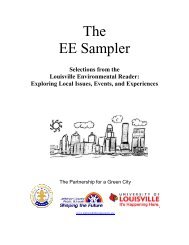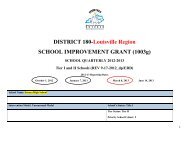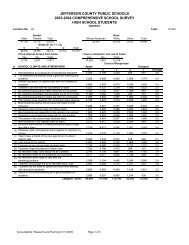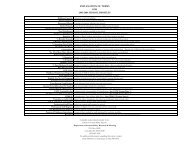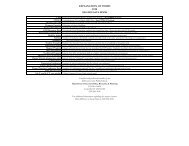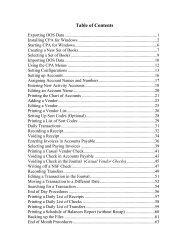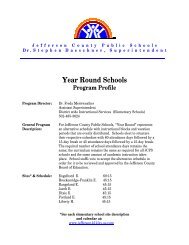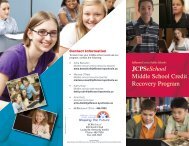exceptional child education - Jefferson County Public Schools
exceptional child education - Jefferson County Public Schools
exceptional child education - Jefferson County Public Schools
You also want an ePaper? Increase the reach of your titles
YUMPU automatically turns print PDFs into web optimized ePapers that Google loves.
Assessments and evaluation of <strong>child</strong>ren with disabilities that transfer from one school district to another in the same<br />
academic year shall be coordinated with the previous and current schools as necessary and as expeditiously as possible,<br />
to ensure prompt completion of full evaluations. 707 KAR 1:300, Section 4(13)<br />
Evaluators must use a variety of assessment tools and strategies to gather relevant functional and<br />
developmental information about the <strong>child</strong> or youth, including information from the parent,<br />
information related to enabling the <strong>child</strong> or youth to be involved, and to progress in the regular<br />
<strong>education</strong> curriculum (or for a preschool <strong>child</strong>, to participate in appropriate activities). The tools and<br />
strategies must yield relevant information that directly assists in determining eligibility for services<br />
and the <strong>education</strong>al needs of the <strong>child</strong> or youth. In the case of a student who has transferred from<br />
another school district, the district shall coordinate with the student’s prior school(s) that have been<br />
involved in the evaluation process to expedite the prompt completion of the full evaluation.<br />
Criteria and Responsibilities of Evaluation Personnel<br />
The lead psychologist ensures that evaluation personnel use the district criteria to select and<br />
administer current editions of the assessment instruments.<br />
Test and procedures used by the evaluators:<br />
A. Have been validated for the specific purpose for which they are used;<br />
B. Are not biased relative to race, culture, or socioeconomic status or impaired sensory,<br />
manual, or speaking skills;<br />
C. Are administered by trained and knowledgeable personnel in accordance with any<br />
instructions provided by the producer of the tests; and<br />
D. Are conducted under standard conditions unless a description of the extent to which the<br />
conditions varied from standard conditions is documented in the evaluation report.<br />
Tests and other evaluation materials include those tailored to assess specific areas of <strong>education</strong>al<br />
need and not merely those that are designed to provide a single general intelligence quotient.<br />
Tests are selected and administered so as to best ensure that when a test is administered to a <strong>child</strong> or<br />
youth with impaired sensory, manual, or speaking skills, the test results accurately reflect the <strong>child</strong>’s<br />
or youth’s aptitude or achievement level or whatever other factors the test purports to measure,<br />
rather than reflecting the <strong>child</strong>’s or youth’s impaired sensory, manual, or speaking skills (unless<br />
those skills are the factors that the test purports to measure).<br />
Assessment tools used are technically sound instruments that may assess the relative contribution of<br />
cognitive and behavioral factors, in addition to physical or developmental factors.<br />
The evaluator makes sure that:<br />
A. He or she uses evaluation procedures appropriate for the age and ability level of the <strong>child</strong><br />
or youth; and<br />
B. Procedures selected are normed on a population that includes <strong>child</strong>ren and youth the<br />
same age.<br />
16 3: Child Find, Eval, & Reeval



